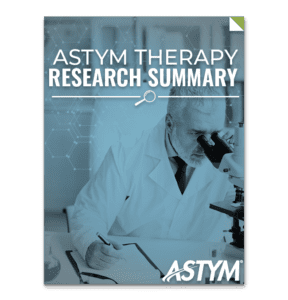
23 Feb Astym therapy vs. IASTM: What’s the difference?
Astym® therapy resulted from a groundbreaking research endeavor undertaken by a multidisciplinary research team including well-known scientists, therapists, and physicians, with support from major universities and hospitals.
Astym Therapy Explained:
In this Astym Research Project, the team had the unique advantage of being able to combine knowledge of physiology, cellular biology, and emerging scientific discoveries into the development of a whole new approach in the treatment of soft tissue dysfunction.
Astym therapy continues to forge new ground in the treatment of injuries and also expand the boundaries of physical therapy into new patient populations. The Astym Research Project developed entirely new theories on how to engage soft tissue healing and changed the actual paradigm on how to treat soft tissue dysfunction. The name “Astym” refers to how Astym therapy engages the body’s natural healing mechanisms – “A-stimulation” of the body’s natural healing response.

Astym therapy, evidenced to engage the regenerative mechanisms of the body and promote the healing of soft tissues, has repeatedly been shown safe and effective in controlled clinical trials, clinical study, and large population outcomes studies.

The Difference:
Astym treatment is different in goals and application from the Instrument-Assisted Soft Tissue Mobilization (IASTM) techniques. IASTM uses tools in a misguided attempt to mechanically break apart tissue, whereas Astym therapy’s aim is to engage the regenerative mechanisms of the body to repair damaged tissue and resorb scar tissue. IASTM’s role in the treatment of soft tissue dysfunction is unclear, as IASTM has been shown to (a) not improve treatment results for particular injuries, (b) be comparable to no treatment being provided in elbow tendinopathy, and (c) result in a significant increase in pain and a significant decrease in the perception of function, where the ability to perform activities of daily living (ADL) decreased following IASTM.
There have been case studies suggesting IASTM may have a role in treatment, however, those studies have largely been multimodal, so conclusions from those are difficult or impossible to draw. A systematic review on IASTM concluded that the current research does not support the efficacy of IASTM for musculoskeletal disorders.
In a Systematic Review of existing research on Astym therapy, authored by leading researchers, they noted that Astym therapy: “is a distinctly different approach than Tooling/Scraping, which is also referred to as Instrument Assisted Soft Tissue Mobilization (“IASTM”). The methods and results are quite different from Astym therapy, and IASTM methods are often not well-tolerated by patients.”
Although Astym therapy utilizes instruments topically, it is a distinctly different approach than Tooling/Scraping, which is also referred to as IASTM. For a quick reference of the differences, see the below graphic describing the large differences between Astym therapy and IASTM.

We Believe In Effective Evidence-Based Care.
For the specific clinical research that led to Astym therapy’s success and for a fully referenced summary of research on Astym therapy and the research behind IASTM, please read this Research Summary.
What Astym therapy Means to Providers:
Astym therapy is part of our larger commitment to healthcare providers. The Astym program is a comprehensive approach to musculoskeletal care and has been partnering with clinics across the nation for years. We’re committed to helping healthcare providers get the most out of their practice by allowing them to engage more with their patients by assisting in other aspects of their practice, such as clinical support, ongoing advanced education, and marketing assistance for their entire clinical career. The Astym program has created a community of elite therapists dedicated to enhancing the lives of their patients and elevating the field of rehabilitation.
Getting Started is Easy:
-
-
- Get Registered
-
-
- Enroll in our Astym therapy course and choose a plan that works best for you.
-
-
- Get Certified
-
-
- Become Certified in just 2-3 days. Astym therapy certification courses are hybrid learning experiences consisting of online education and on-site training.
-
-
- Get Results
-
-
- After certification, start treating immediately and get results that will make you the go-to clinic in your area! Enjoy increased referrals, better outcomes, and less wasted time and resources.
-
-
- Get Registered
-
What Astym therapy means to Patients:
Astym therapy offers patients a trusted treatment plan that’s proven to work fast and give lasting results. Patients like that it’s non-invasive meaning no injections and no surgery.
With over 10,000 independently recorded patient cases, Astym therapy resolves over 92% of patients across all musculoskeletal disorders (even the toughest cases).
Patients are active participants in their recovery and can continue to play sports, go to work, and do other activities while enrolled in Astym therapy. By staying active, the old injured area will get stronger and heal the way it was supposed to!
How To Start Your Recovery:
-
-
- Find A Provider
-
-
- Search your city or zip code to contact an Astym Certified provider in your area and see if Astym therapy is right for you.
-
-
- Get Treatment
-
-
- After conducting a thorough evaluation to make sure Astym therapy is right for you, your certified therapist will walk you through a treatment plan tailored to your needs.
-
-
- Live Pain-Free
-
-
- We believe everyone deserves to live pain-free no matter their injury or condition. With Astym therapy, you can feel better, move better, and get back to the activities that you love to do.
-
-
- Find A Provider
-
Other Articles You Might Like:
- Going to your first Astym therapy appointment? Here’s what to expect during your first visit.
- Tired of reading? Take a break and listen to this podcast, An Effective Treatment for Scar Tissue, to enjoy 10+ years of research and clinical study in under 9 minutes!
- Looking for a competitive edge? Check out these Clinical Tips & Tricks!
Originally published February 23, 2016, updated June 8, 2020.





